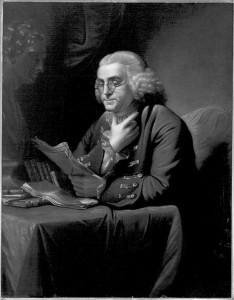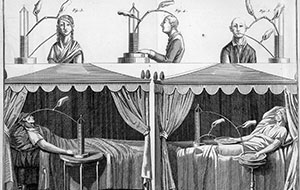By Bart Lutters and Peter J. Koehler

Portrait of Jan Ingenhousz (1730-1799)
Electroconvulsive therapy (ECT) is considered a highly effective treatment for drug-resistant depression. The discovery of ECT has generally been attributed to the Italian psychiatrist Ugo Cerletti (1877-1963), who, in April 1938, managed to induce seizures by applying electricity directly to the head of a schizophrenic patient. Even though Cerletti’s achievement has greatly contributed to the widespread implementation of cranial electrotherapy, the first reports on this seemingly hostile procedure date back even earlier.
The notion that cranial electrotherapy may provide a useful therapy for melancholic patients can be traced back to a letter written by the Dutch scientist Jan Ingenhousz (1730-1799) in 1783. In his letter, Ingenhousz told his correspondent, none other than Benjamin Franklin (1705-1790), of an electric accident that he had recently endured. While Ingenhousz had attempted to reconstruct a thunderstorm in his laboratory, a powerful shock accidently struck his head:
The yarr [Leyden jar] by which I was struck contained about 32 pints. It was nearly fully charged when I recived the explosion from the conductor supported by that jarr. The flash enter’d the corner of my hat. Then, it entered my forehead and passed thro the left hand, in which I held the chaine communicating with the outward coating of the yarr. I neither saw, heared nor [sensed?] the explosion by which I was struck down. I lost all my senses, memory, understanding and even sound judgment.

Portrait of Benjamin Franklin (1705-1790) by Charles Willson Peale (1772)
My first sensation was a peine [pain] on the forehead. The first object I saw was the post of a door. I combined the two ideas together and thought I had hurt my head against the horizontal piece of timber supported by the pos[ts?], which was impossib[le] as the door was wide and high. After having answered unadequately to some questio[ns] which were asked me by the people in the room, I determined to go home … yet I was more than two minutes considering whether, to go hom[e] I must go to the right or the left hand.
Having found my lodgings, and consider[ing] that my memory was become very weak, I thought it prudent to put down in writing th[e] history of the case. I placed the paper before me, dipt the pen in the ink, but when I applyed it to the paper, I found I had entirely forgotten the art of writing and reading and did not know more what to doe with the pen, than a savage, who never knew there was such an art found out. (Papers of Benjamin Franklin, n.d., Vol. 40, Unit 209. Interpreted by Stanley Finger)
In deficient English, Ingenhousz clearly describes a case of retrograde amnesia, a common consequence of head injury, which would be more thoroughly described by Benjamin Brodie (1817-1880) in 1857. This amnestic phenomenon was familiar to Franklin, who had previously suffered an electric blow to the head himself:
I had a Paralytick Patient in my Chamber, who’s Friends brought him to receive some Electric Shocks. I made them join Hands so as to receive the Shock at the same time, and I charg’d two large Jars to give it. By the Number of those People, I was oblig’d to quit my usual Standing, and plac’d myself inadvertently under an Iron Hook which hung from the Ceiling down to within two Inches of my Head, and communicated by a Wire with the outside of the Jars. I attempted to discharge them, and in fact did so; but I did not perceive it, tho’ the charge went thro’ me, and not through the Persons I entended it for. I neither saw the Flash, heard the Report, nor felt the Stroke. When my Senses returned, I found myself on the Floor. I got up, not knowing how that had happened. I then again attempted to discharge the Jars; but one of the Company told me they were already discharg’d, which I could not at first believe, but on Trial found it true. They told me they had not felt it, but they saw I was knock’d down by it, which had greatly surprised them. On recollecting myself, and examining my Situation, I found the Case clear.

Illustrations of melancholic patients treated with cranial electrotherapy by Giovanni Aldini (1762-1834)
Just like Ingenhousz, Franklin had not been able to recall the electric accident. Despite monumental blows to their heads, neither of the two men reported any permanent damage. On the contrary, as appears from Ingenhousz’ continuing account, he experienced something quite astonishing the morning after his accident:
My mental faculties were at that time [the next morning] not only returned, but I felt the most lively joyce in finding, as I thought at the time, my judgment infinitely more acute. It did seem to me I saw much clearer the difficulties of everything, and what did formerly seem to me difficult to comprehend, was now become of an easy Solution. I found moreover a liveliness in my whole frame, which I never had observed before.
Franklin was fascinated by the story of his Dutch correspondent. Ingenhousz had not only survived the accident, but had experienced a considerable improvement in his mood following the accident. Even though Franklin himself had not noticed any perks of his electric mishap, both men agreed that cranial electrotherapy could potentially provide an effective therapy for melancholic patients. Consequently, they both set out to persuade various “mad-doctors” in London and Paris to expose the heads of their melancholic patients to cranial electricity.
In 1787, four years after Ingenhousz’ letter to Franklin, John Birch (1745-1815), an English surgeon and electrotherapist, proclaimed the healing of a melancholic porter and a suicidal singer by means of cranial electrotherapy. Birch’s achievements were soon followed by similar reports from Giovani Aldini (1762-1834) and T. Gale. Even though none of these physicians made any reference to Franklin or Ingenhousz, given the chronology of events, it seems plausible that the two prominent scientists inspired them.
It is time to include Jan Ingenhousz and Benjamin Franklin in the ECT story. Ingenhousz, a talented physician-scientist best known for his discovery of photosynthesis, was the first to report the positive effects of cranial electricity and to advise the procedure for the treatment of melancholic patients. Franklin, already widely celebrated for his electric research, owns his share in the conception of cranial electrotherapy, as well. Finally, even though Cerletti was probably the first to induce seizures by means of cranial electricity, the early cranial electrotherapists Birch, Aldini and Gale deserve credit for pioneering cranial electrotherapy.
Sources
Beale, N., & Beale, E. (2011). Echoes of Ingen Housz: The long lost story of the genius who rescued the Habsburgs from smallpox and became the father of photosynthesis. Hobnob Press.
Beaudreau, S. A., & Finger, S. (2006). Medical electricity and madness in the 18th century: the legacies of Benjamin Franklin and Jan Ingenhousz. Perspectives in biology and medicine, 49(3), 330-345.
Finger, S. (2012). Doctor Franklin’s medicine. University of Pennsylvania Press.
Finger, S., & Piccolino, M. (2011). The shocking history of electric fishes: from ancient epochs to the birth of modern neurophysiology. Oxford University Press.
Finger, S., & Zaromb, F. (2006). Benjamin Franklin and shock-induced amnesia. American Psychologist, 61(3), 240.
Shorter, E., & Healy, D. (2013). Shock therapy: a history of electroconvulsive treatment in mental illness. Rutgers University Press.
